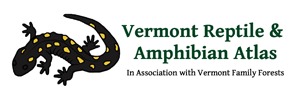Herp Update: Amphibian Crossing, Updated Reports, Snake Migration, Herp Hat – October 30, 2024
Recent Herp Activity
Morgan Road in Salisbury
During last night’s rain, I spent 20 minutes at our Morgan Road Crossing here in Salisbury. A light rain started around 8 PM and intensified for the next few hours. The temperature was 46 F. It felt cold at this time of year, but in the spring we would have considered it quite warm. I took one walk over and back through the crossing area and was pleased to find 51 Eastern Red-backed Salamanders, 16 Four-toed Salamanders, 7 Blue-spotted Group Salamanders, and three Wood Frogs. The Red-backs were mostly adults, but the other species were a mix of young and adults. Looking at the weather forecast, we may see amphibian movement again early next week.
Active Searches to Update Reports
Earlier in the day yesterday, Kate Kelly and I made a very successful effort to update amphibian reports in Whiting, Rutland City, and Mendon. As I have mentioned before, we have been gathering records for the Herp Atlas for thirty years now. That means some of our earlier reports are now considered “historic” (over twenty-five years old) and we need to update them. The goal in Whiting was simply to update a photo report of Eastern Red-backed Salamanders. Much of Whiting is open land, or early successional woodlands not appropriate for our target species. After a quick visit to one site that was mid-successional pine with young hardwoods, we headed to Bond Island. Bond Island is one of a handful of islands within the Otter Creek Swamps. It is owned by the Nature Conservancy. After wading in along the access road, we came to a really nice looking area of mature, mixed northern hardwoods along the edge of the island. This forest is immediately adjacent to a large forested swamp. We set to work turning downed logs, branches, rocks, and other cover objects. Within 15 minutes, not only did we find and photograph Eastern Red-backs, we also discovered a large population of Four-toed Salamanders. This was the first time Four-toeds had been documented in Whiting.
After searching unsuccessfully to see if might also find Blue-spotted Salamanders (not rocky enough?), we drove to a park in Rutland City and quickly found our target species, Northern Two-lined Salamanders, there. Although finding them was not an issue, catching and photographing them proved challenging, but we prevailed.
The last stop was Aitken State Forest in Mendon where we quickly and easily updated reports for Northern Two-lined (the target) and Eastern Red-backed Salamanders.
The Eastern Red-backed Salamander shown below is a very unusual speckled, brown color morph that we found in Burlington earlier this month (photo by Kate Kelly).

Snakes Still on the Move
Looking at all our snake-migration records (for our cold tolerant species) movement peaks during the last 10 days of October and then comes to an end in early November. However, climate change may change traditional migration times.
The forecast looks excellent for snakes to move during the warm temperatures tomorrow (Thursday, October 31). Walking quiet roads between foraging habitat (wetlands, overgrown fields), and well-drained rocky uplands is a good way to find them.
Ira Powsner and I managed to update the photo record of a DeKay’s Brownsnake in Leicester last week. The temperature was too cold for the snakes to be moving, so we had to find and identify flattened, road-killed snakes from earlier in the week. We found Common Watersnakes, Common Gartersnakes, and one DeKay’s.
My wife Kris took the photo below of our DeKay’s Brownsnake. The ID was not immediately obvious. We had to look closely at the small black head markings (below each eye, sideburns, and on each side of the neck) to be sure of the species. We could also see the checkerboard pattern that is usually visible on the sides of DeKay’s Brownsnakes.

Herp Atlas Hat Discovered Near a Remote Lake in the Olympic Mountains of Washington State
In late August, Kent McFarland of The Vermont Center for Ecostudies sent me the e-mail and photo below.
“My sister lives in WA and texted me this image. She found it randomly in the middle of nowhere in Olympic National Park at Milk Lake while backpacking last week . It fits my brother-in-law perfectly so there’s a random guy wearing this in Bellingham, WA now”.
Does anybody know how this hat ended up at this remote location in Washington?


